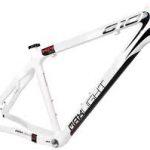Five Types of Mountain Bike Framing Materials
 If you don’t know what you’re looking for when you buy a mountain bike, it’s easy to get lost in a confusion of bike lingo. You want to get the highest quality bike you can afford, but what makes one bicycle worth so much more than another? Many components go into a bicycle, and many of them can be changed out later if you find you chose the wrong kind for your style of riding. One component, though, can’t be changed without buying a whole new bike, and that’s the frame.
If you don’t know what you’re looking for when you buy a mountain bike, it’s easy to get lost in a confusion of bike lingo. You want to get the highest quality bike you can afford, but what makes one bicycle worth so much more than another? Many components go into a bicycle, and many of them can be changed out later if you find you chose the wrong kind for your style of riding. One component, though, can’t be changed without buying a whole new bike, and that’s the frame.
A bicycle’s frame makes up the bulk of the bike, and the kind of frame you buy determines much of your riding experience. You’ll have a choice of five different materials for your bicycle frame. Each of them has different benefits and drawbacks. And while some are obviously higher or lower quality, your choice between others is more a matter of personal preference.
High-Tensile Steel
High-tensile steel is an alloy, or combination, metal with a high carbon content. It’s used for bicycle frames at the lowest end of the quality and price spectrum. On the positive side, high-tensile steel tends to be very durable. On the other hand, it tends to have too much give on its own, so other materials have to be added to make it suitable for a mountain bike frame. That makes this the heaviest option for a bike frame. It you don’t ride often, or if you want to start with a cheaper bike and see if you’re going to stick with bicycling before you spend too much, a high-tensile steel frame may be your best bet. But if you ride a lot, you’ll probably find the frame too heavy to suit you.
Chromoly Steel
Chromoly steel is an alloy of chromium and molybdenum. It’s been the go-to choice for mountain bike frames for decades. Chromoly steel is lighter weight than high-tensile steel but still very durable. This is one of those framing materials that some people love and others hate depending on personal taste and riding style. You’ll be able to find chromoly frames at both ends of the price spectrum.
Aluminum
Aluminum is a good choice for a bike frame if you want something that’s lighter weight than either of the steel options. It may be the best choice for dual-suspension bikes. However, aluminum tends to crack more easily than steel. Whether or not you’ll like an aluminum frame is also a matter of personal preference and riding style. It tends to fall in the mid-price range.
Titanium
Many cyclists consider a titanium frame to be the pinnacle mountain biking experience. Titanium combines the durability of steel with the light weight of aluminum. Not only will your titanium-framed bicycle ride well and last a long time, it will look good, too, since the metal has a natural shine to it. Not surprisingly, you can only find titanium mountain bike frames at the high end of the price spectrum.
Carbon Fiber
If your main concern in a bicycle is to get the lightest weight possible, a carbon fiber frame is the way to go. It works well for speed in a road bike. However, if you plan to ride off road, you’ll probably be disappointed with a carbon fiber frame. They are not very durable and may crack at your first crash. You’ll have to put a lot of care into maintaining your frame. A carbon fiber frame may be beautiful, and they’re certainly expensive, but they’re not very practical on a mountain bike.
